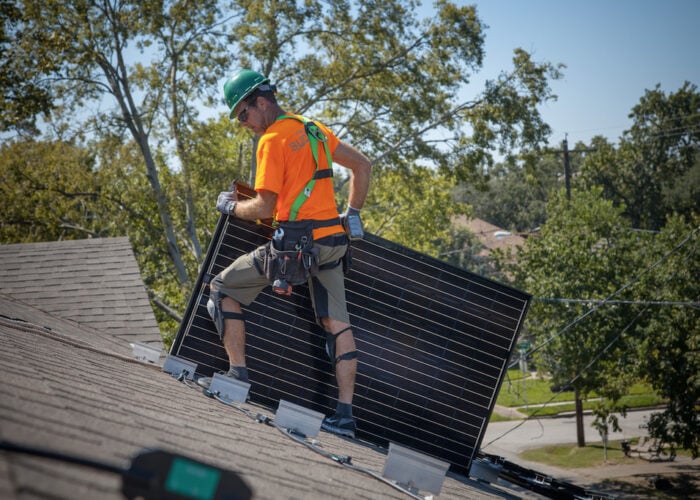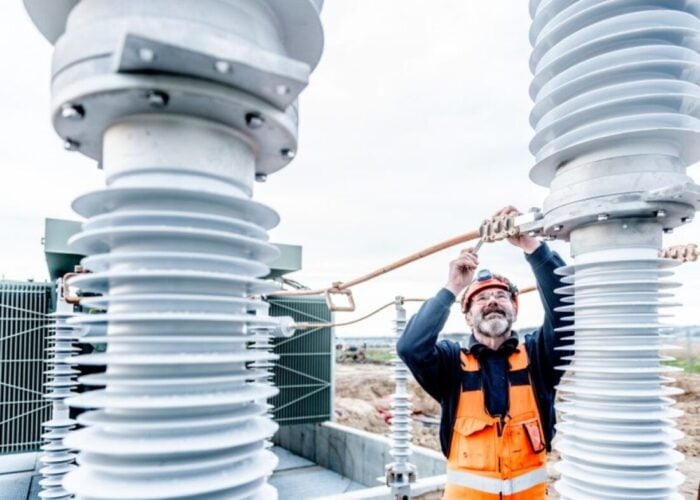“Are you already working on third-generation solar cells in pilot scale?” This is one of the questions that CTOs of solar cell companies are often asked. The answer from, for example, Pierre Verlinden, chief scientist at Trina Solar, is always very simple: “We are still very happy with first-generation and there is plenty room for improvement – thank you!”
He is right. In the next 15 to 20 years there is hardly any “revolution” to be expected on the PV market and this is also what Massachusetts Institute of Technology researches have forecasted.
Unlock unlimited access for 12 whole months of distinctive global analysis
Photovoltaics International is now included.
- Regular insight and analysis of the industry’s biggest developments
- In-depth interviews with the industry’s leading figures
- Unlimited digital access to the PV Tech Power journal catalogue
- Unlimited digital access to the Photovoltaics International journal catalogue
- Access to more than 1,000 technical papers
- Discounts on Solar Media’s portfolio of events, in-person and virtual
When you look at the efficiency improvement curve of c-Si solar cells in production within recent years, they are quite constantly approaching the theoretical limit of 29%, which should be reached around 2030. This will be achieved by improving the metallisation, emitter, passivation and material quality. The question is: what next? Is a revolution to be expected? Will the evolution somehow continue? How?
As already discussed in our last PV Tech blogs, here and here, cell efficiency is not the only important measure to be improved for minimising levelised cost of energy (LCOE). Tricks to reduce cell-to-module losses (or even achieve CTM gains) are extremely important, as well as module power-enhancing technologies such as bifaciality, tracking and concentration. However, the increase in efficiency is also in the focus of R&D centres and an often-asked question from the industry side is what will happen in more than 15 years with c-Si. This blog summarises what will most likely happen in future.
Will the old-fashioned, first-generation c-Si PV technology be replaced by second- and third-generation PV?
A commonly used classification divides the various PV technologies (in commercial as well as in R&D stage) into three generations [1]:
- First generation, G1: wafer based; mainly mono c-Si and mc-Si
- Second generation, G2: thin film; a-Si, CdTe, CIGS, CuGaSe,
- Third-generation, G3: multi-junction and organic solar cells (OPV), dye sensitised (DSSC) and solar cells based on quantum dots as well as other nano-materials
This nomenclature suggests that the Si-based PV technologies will be replaced – sooner or later – completely by the second and third generation.
Looking at the record efficiencies, the 46% obtained under highly concentrated sunlight by Soitec/Fraunhofer with a four-junction solar cell (see Fig. 2) is a value that is far beyond the theoretical limit of Si based PV (29%). The same applies to the 38.8% (no concentration) by Boeing/Spectrolab. However, this type of PV technology (multi-junction) has a very high module cost (USD/Wp) that may only be justified for space applications (high energy density, Wp/kg), but not for large-scale, terrestrial deployment, where LCOE (USD/kWh) is the final criterion.
On the other hand, there are third-generation technologies that enable a very low module manufacturing cost, such as OPV and DSCC but, even 30 years after their discovery, for none of them has commercial manufacturing of modules with long-term stability (comparable to c-Si modules) been possible. In addition, the low efficiency level results in an increased BOS-cost and excessively high LCOE – at least if integrated in large, ground-mounted PV systems.
Looking at the commercially implemented thin-film technologies, there are mainly three technologies: CdTe, CIGS and a-Si. Due to its low specific silicon consumption, a-Si PV technology boomed mainly between 2005 and 2008, when polysilicon prices of US$450/kg or higher contributed substantially to the high manufacturing cost of multi- and monocrystalline Si wafers. Meanwhile, at a polysilicon price level of US$20/kg or less, with maximum commercial module efficiencies of around 12%, a-Si is not competitive any more compared to c-Si PV.
CdTe, which has the biggest market share of all thin-film technologies and CIGS both reach over 20% record efficiencies (see Fig. 2) and feature decent commercial efficiencies as well as a good long-term module stability.
Apart from the toxicity of certain elements (such as e.g. cadmium), the abundance of elements in the earth's crust and, more specifically, worldwide annual production will become an issue when considering PV deployment targets as high as a 50% share of total electricity production by 2050, as some of the more ambitious scenarios have projected. Fig. 3a), 3b) and 3c) [1] show the following:
- for c-Si, the current annual production of Ag (currently needed for the metal contacts) and of Si does not represent a limitation for reaching 50% PV share in 2050 – even though Ag consumption should be reduced in order to realistically reach the target
- being strongly limited by availability of Ga, Te, Se and In, the commercially implemented thin-film technologies CdTe and CIGS are not suitable for a very large-scale deployment of PV
- from the point of view of availability of the required raw materials, emerging thin-film technologies, such as Perovskite, CZTS and quantum dot-based solar cells, can be suitable for large-scale deployment of PV with the target of reaching 50% share of PV in total electricity production by 2050.
Summarising the above discussion of various PV technologies from first, second and third generation, regarding their maturity, complexity of manufacturing process, costs, efficiency potential and the availability of the required raw materials, it is very likely that the first-generation c-Si work-horse will not be replaced by any of G2 and G3 technologies that are currently commercially implemented but by some emerging PV technology (or some technology that is still to come).
Consequently, c-Si PV technology will be replaced not sooner, but rather later. But before being replaced by something new, the energy conversion efficiency of c-Si commercial modules will be pushed to the theoretical limit (29.7% for non-concentrating PV [2]) and beyond, by further improvement of material quality, cell designs and surface passivation technologies – but also by combining c-Si with other materials and technologies, some of them being part of the third PV generation. This will be discussed in the following section.
Combination of c-Si technology with other materials
C-Si PV nowadays is less and less exclusively c-Si PV. The bulk material is a 140-200µm thin c-Si wafer; however here are many components in the module besides silicon. Especially on a module level, more and more advanced materials are these days entering the “G1 c-Si module technology” in order to further minimise the cell-to-module (CTM) losses at an efficiency level. CTM losses at a power level can be even more minimised with tricks such as, for example, increasing the spacing in between the solar cells (and collecting the additional reflected light in the spaces) in monofacial mode or using bifaciality.
Efficiency enhancements, by increasing the current density, can be done basically with thre different technologies:
- ARC or light trapping (minimising the losses for existing photons)
- Adjustment of the light spectrum (creating new photons to be absorbed by c-Si)
- Use of Si or additional semiconductor material with different band gap (tandem: create a broader absorption window)
All these technologies, mostly nanotechnologies, can be used either at a cell level or at the module level.
For point 1, above, there are many products on the market such as KhepriCoat from DSM, which is deposited on the glass by glass manufacturers in order to reduce the CTM losses. Nano-imprint, a technology that is well known from the semiconductor industry, can be used at a cell level to replace wet chemical texturing and therefore minimise the surface area to be passivated and enhance the Voc of the cell as well. A plasmonic particle layer (PPL) could work in a similar way as nano-imprint. In addition, light trapping nano-coating films can be used instead of ARC in order also to maximise the electricity generation also by coupling in light independently of the angle of incidence.
For point 2, there are a few possibilities, such as down-conversion. Silicon quantum dot (Si-QD) layers can be applied to downshift incident radiation to longer wavelengths better suited to the absorption spectra of crystalline silicon. To improve light interaction, the Si-QD layer can be additionally coated with a PPL. This PPL plays the role of texturing but without increasing the effective surface area and surface recombination, which was successfully done for example in the EU project LIMA.
For point 3, two or more band gaps (Si/Si modified or Si/semiconductor e.g. nanowires of compound semiconductors) can be used in order to increase the absorption ability of the device – similar to how it is done with the III-V technology. Then for example CdTe or GaAs thin-film or nano-wires could be a good candidate to be used in combination with c-Si technology – or as discussed in the previous paragraph, Perovskites could be used in future in combination with c-Si.
Evolution from G1 to G3
In summary we are sure that there will be no replacement of G1 in the near and mid-term future – rather a slow transformation to G3 by using advanced c-Si technology in combinations with various nano-technologies at a cell and module level as schematically depicted in Fig. 4. Then, with such devices we could enter cost-effective 60-cell, 6-inch module technology with more than 0.5kWpe (Watt peak effective).
As Si PV in combination with nanotechnologies is becoming an extremely hot topic there has been a new EU project launched with about 50 partners from many EU countries: COST MultiscaleSolar. The goal is to create a network of experts to exploit the implementation of nano-technologies in next-generation c-Si solar cell architectures. This requires novel multi-scale modelling and characterisation approaches which capture both the peculiar features at nanoscale and their impact on the optoelectronic performance at device levels. New partners with expertise in this field are welcome to enter the nano-board.
References:
1 – Green, M.A. 'Third Generation Photovoltaics: Ultra-high Conversion efficiency at Low Cost', Progress in PV: Research and Applications 9, no. 2 (2001): 123-135.
2 – A. Richter, M. Hermle, S.W. Glunz (Oct 2013). “Reassessment of the limiting efficiency for crystalline silicon solar cells”. IEEE Journal of Photovoltaics 3 (4): 1184–1191.







